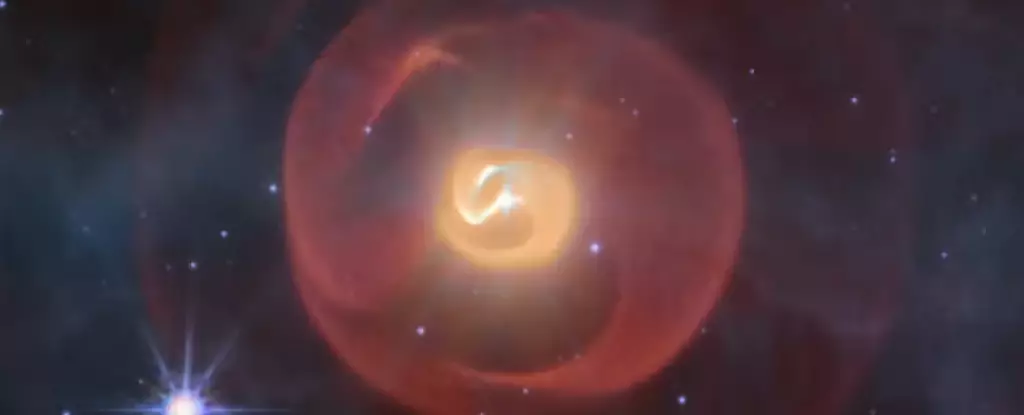In an era where vast telescopes and cutting-edge technology unravel the universe’s deepest secrets, the story of Apep stands as a testament to human ingenuity and our relentless pursuit of knowledge. When the infrared image from the Very Large Telescope first revealed spiral dust encircling dying stars, it was more than a scientific find; it was a moment of awe, a glimpse into the violent yet beautiful processes that shape our cosmos. This particular cosmic serpent, named Apep after the ancient Egyptian deity of chaos and destruction, symbolizes both the destructive power of stellar death and the birth of cosmic dust—materials that eventually coalesce into planets, life, and perhaps consciousness itself.
Now, with the James Webb Space Telescope (JWST), astronomers have taken this discovery to new heights, quite literally. The enhanced detail and sensitivity of JWST have exposed complexities previously hidden, transforming our understanding of this celestial phenomenon from a simple spiral nebula into a complex interaction of multiple stellar forces and history. What was once an elegant pinwheel is now a dynamic story of star pairs, dust shells, and cosmic evolution. This evolution isn’t just about distant stars; it fundamentally challenges our preconceived notions about how massive stars live, die, and influence their surroundings—even their own eventual demise.
Beyond Expectations: The Unexpected Complexity of Apep
Initial expectations were straightforward: a binary Wolf-Rayet system producing a symmetric spiral pattern as stellar winds collide and carve out a nebular masterpiece. These Wolf-Rayet stars, known for their fierce winds and brief-lived tungsten halos of heavy elements, are in the final stages of their lives. When massive stars exhaust their core hydrogen, they shed their outer layers in intense outbursts, creating an environment ripe for dust formation. This dust, primarily carbon-rich, is not merely debris; it is cosmic fabric, a pollen cloud that sows the seeds for future star and planet formation.
In theoretical models, such interactions should produce a neat, pinwheel-shaped nebula. Yet, JWST’s infrared imagery shattered this expectation. Instead of a uniform spiral, what emerged was a chaotic, wind-sock shape, indicating a more turbulent reality. The nebula revealed two Wolf-Rayet stars of similar strength—an intriguing detail because many massive systems tend to be skewed or unequal. The newfound complexity suggested that the system harbored a third star—an elusive sibling previously unconfirmed. The dust shells, evenly spaced but distinct, further hinted at a complex dynamical history, with multiple episodes of dust ejection and a rich tapestry of stellar interactions.
This discovery underscores a fundamental flaw in our simplistic assumptions about stellar systems: beauty and chaos often coexist in ways that defy initial models. The “bite” in the dust shells, caused by the third star’s winds, is a compelling visual cue that these systems are more than binary; they are multi-star families whose interactions leave indelible marks in their nebular footprints.
Implications for Cosmic Evolution and Stellar Life Cycles
Understanding Apep is akin to unlocking a cosmic chronicle written in dust and gas. The evolution of Wolf-Rayet stars, especially in binary systems, is essential for comprehending how the universe recycles matter. These stars, on the cusp of exploding as supernovae, are the universe’s forges for heavy elements, contributing significantly to the cosmic inventory of carbon, oxygen, and other life-essential materials.
What’s particularly compelling about Apep is how its structure reveals the late-stage dynamism of these stars. The newly observed dust shells indicate multiple mass-loss events spread over time, suggesting a complex interplay of stellar winds, rotational velocities, and gravitational influences. The possibility that some of this dust originates from ancient, slower winds challenges previous notions that only rapid, energetic ejections shape such nebulae. Instead, the evidence points toward a layered history—stars spinning rapidly, shedding matter in episodic bursts that gradually build the observed cosmic sculpture.
Moreover, JWST’s detection of the stars’ precise distances and the faint, cool dust shells further amplifies their importance. If these stars are more luminous than initially believed, their influence on their galactic neighborhood is even more profound. They serve as cosmic alchemists, transforming simple hydrogen and helium into complex carbon compounds, all the while setting the stage for future star and planet formation. The aftermath of such violent but beautiful death throes leaves behind dust that will eventually seed new worlds.
Redefining Our Cosmic Narrative
What makes the story of Apep so fascinating—and perhaps somewhat humbling—is how it challenges established paradigms of stellar evolution. We tend to think of stars as predictable objects—lifespan, death, and rebirth—yet Apep reveals that the universe writes its own rules in bursts of chaos and order intertwined. The presence of multiple dust shells, the influence of a third star, and the unexpected shape of the nebula itself suggest that our understanding of stars’ final acts is still in flux.
More than just a scientific curiosity, Apep embodies the universe’s relentless capacity for surprise. Each new layer of data, whether revealing cooler dust shells or precise stellar motions, forces a reevaluation of earlier theories. It also reminds us that the cosmic dance is endlessly intricate; what appears elegant at a distance is often a violent concert of winds, gravitational pulls, and explosive forces when viewed up close.
The combination of cutting-edge technology and human curiosity continues to push the boundaries of what we know. In the case of Apep, our obsession with understanding stellar death not only informs astrophysics but also provokes deeper philosophical reflections about our place in a universe governed by perpetual transformation—chaotic yet ultimately creative. This celestial serpent, spinning through space in a majestic encore of destruction and renewal, invites us to consider the profound beauty hidden within cosmic violence.

